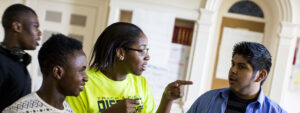Ahniwake Rose, a citizen of the Cherokee Nation and of Muscogee/Creek descent, is the Executive Director of the National Indian Education Association (NIEA), which works to improve educational opportunities for Native students. For almost 50 years, NIEA has brought educators together to explore ways of improving schools and educational systems to serve Native children, and support the continued development of language and cultural programs. With the passage of the Every Student Succeeds Act (ESSA), state and local education agencies will be working to connect with Native communities to make sure their voices are included in conversations about how to improve their schools. We sat down with Ahniwake to talk about what that will look like, and how schools can be better supported to engage effectively with Native communities.
Can you tell us what the National Indian Education Association (NIEA) does to support Native school communities?
NIEA is working to improve Native school communities by giving educators the tools they need to support Native students in reaching their full potential, inside and outside of the classroom. Our goal is to create well-rounded Native citizens.
One way we are working to accomplish this is through curricula that reflects the students and the communities they live in. To make sure this happens, NIEA is working to bring Native history, current events, and civic opportunities to all students. Our goal is to help students of all backgrounds feel empowered by what they’re learning.
NIEA also provides advocacy and policy assistance at the state and federal level. Most recently, we have been focused on the ESSA roll-out. This is the first time many state and local education agencies have had to consult with tribes and Native communities and NIEA is engaged at multiple levels to ensure that the process is successful for all. We put out a guide called “Building Relationships with Tribes: A Native Process for Ethnic Consultation,” which provides guidance on how these agencies can begin the work of developing long-lasting relationships with tribes and Native communities.
What kind of relationship have you seen between government education agencies and Native American communities in the past?
The history of Indian education policy in this country is very different from what the majority of America knows or has experienced. Western, formal Native education began with a federal policy based on “Kill the Indian, Save the Man.” Our communities are still healing from decades of failed federal policy. NIEA has created a resource for those interested: “Native Nations and American Schools: The History of Native in the American Education System.”
While it is important that we acknowledge the past and consequences of past mistakes, it is equally important that we look toward the future. The passage of ESSA provides us that opportunity. Native education sees three major advancements in ESSA:
For the first time, there is a requirement for timely and meaningful consultation between tribal leaders and local and state education agencies. This is the first time our tribes will be at the table, meaningfully engaging with states and localities on the education of their tribal citizens.
Under ESSA, we also see—for the first time ever—funding for language programs in public schools. My father, grandmother, and grandfather all went through the American Indian boarding school system, and weren't allowed to speak their languages at school. Two generations later, we have the opportunity for our languages to be taught in public school.
The third piece we're really excited about is the opportunity for tribes to run their own Indian Education programs in schools that serve their students. To do this, a tribe and the state and district must enter into a cooperative agreement. These agreements establish strong partnerships, ensuring that all parties are working together to meeting the academic and cultural needs of students.
Do you have some examples of states or school districts that are proactively engaging their Native communities? Some bright spots?
Absolutely, there are a lot of bright spots. Just as tribal nations are unique, state approaches to working with their tribes are unique. You're going to have to tailor the outreach based on the community and tribe.
Washington state, for example, is at the forefront of thinking about how tribes can become actively engaged partners. I mentioned that ESSA gives tribes the opportunity to run programs of their own. Washington did excellent work thinking about how tribes can start these programs. The Governor meets annually with tribal leaders, and education is one of the top issues that they discuss. Additionally, the state Indian Education Director regularly meets with tribal leaders, and goes on visits around the state to make sure schools are running in the way that the tribes would like them to, so it's a two-way relationship.
Another example of engagement is New Mexico, where tribes have been driven to establish a trusting relationship with public school leadership before engaging with the state leadership. Jemez Pueblo tribal education leadership entered into a collaborative relationship with the public and Bureau of Indian Education schools located on Jemez Pueblo land. The education collaborative jointly planned professional development calendars to align with each other. Collaborative meetings are held for all staff and leadership to come together, share successes, discuss challenges, and learn from one another.
I also want to acknowledge the hard work that's taking place in South Dakota. For the first time ever, they developed a state Indian education advisory committee. You now have tribal leaders that are speaking to the state superintendent and notifying them about the needs in their schools.
Each state is on a different trajectory, but what NIEA is trying to do is identify best practices, and find out the right ways to replicate and adapt these practices to different communities.
I agree that every individual community is unique, but if you were to give more general advice to a state or district about how to earn the trust of Native communities, what would you say?
That’s really timely because we just released a tribal consultation guide. The model we use has four essential elements. The first is that consultation should be consensus-based, which we all know can be incredibly challenging. Our approach to consensus-based decision making is not necessarily that every person has to agree, but we do believe that every person needs to have a voice.
The second is everybody needs to walk into the consultation process with mutual respect. That means going to the community, not just expecting the community to come to you. It also means providing the community with the tools they might need to voice their concerns, because for some folks this is the first time they've had an opportunity to speak with a state education official.
The third is cultural awareness. The agencies that are building partnerships need to be knowledgeable about their Native communities. I’ve seen agencies go out and speak to a community without knowing prior historical encounters among state leadership, school leadership, and tribal communities. It is critical that state agencies and education partners understand the history of the area, and the number of tribes that school districts serve. Being familiar with the issues your Native community cares about from the beginning is essential to establishing a trusting relationship.
The fourth is sustained progress. Consultation is not a one-time box-checking event. It’s an ongoing reciprocal relationship, which means that once the first consultation is complete, you're going to go back to the community and say, “These are the pieces we are going to be able to incorporate and why, and these are the pieces we aren't going to be able to incorporate and why.” It is not enough to involve tribes on just one issue, or even just Indian issues. You have to go back into those communities and speak with them regularly and provide multiple opportunities for engagement.
It's going to take a sustained effort to build the reciprocal relationships that are needed. It took decades to get to where we are today, and it might take decades for us to heal these relationships. But we're all in this together because our students deserve more.
That makes a lot of sense. Earlier, you mentioned the work NIEA does to make sure students are seeing themselves in the learning process. Can you talk more about that?
Far too often, the only time Native people are thought of in school is around Thanksgiving. But Native peoples and our communities are vibrant, active, contributing members of our states and the nation. Schools and classrooms have so many opportunities now, through a standards-based curriculum, to infuse teaching with the culture of the Native community where students live.
Teachers should take the opportunity, for example, to teach an author of Native descent. By doing so, Native students in the classroom will be so much more engaged, just as all students are when what they’re learning reflects who they are.
Really, we should all take a step back and try to erase some of the norms that have become so commonplace. Recently, there’s been an increasingly publicized debate around team mascots. Though much of what we’re hearing about involves professional and college sports, it’s important we consider K-12 mascots too. We want each student to walk into that classroom at the beginning of the school year thinking anything is possible. What does this mean for the Native student who walks in and realizes that there's a gigantic Chief Wahoo head that's painted on their wall, but not ever a mention of them in their classroom, unless it's about either Thanksgiving or the many negative events that Native people have suffered?
There are so many current event opportunities to use as examples. If a teacher wants to talk about environmental issues or civics and governments, they can just turn to Standing Rock. The NIEA would love to help them do so, or point them toward opportunities and resources in their area. Almost every state with a high Native population has a state Indian education organization that’s ready to assist, too.
I'm so glad you brought that up. We need to be more aware of how this sort of thinking can engage students who don't see themselves in what they’re learning, across communities and backgrounds.
Exactly. As I say often, these issues are not specific to Indian country. At my daughter’s school for example, just one month a year is dedicated to studying African American history. But 80 percent of the student population is African American. It’s a serious problem.
This is not about approaching teachers from a deficit perspective. They're dedicated to supporting our kids, and we want to provide them with the tools and resources that they need to thrive.
Really, it comes down to understanding that we’re all in this together. Don’t just describe Native people in total isolation on reservations. We're active economic contributors, and everyone has a vested interest in how our students perform. As we implement ESSA, as long as we take the time to listen to our Native communities, we will be able to improve Native education for all.




